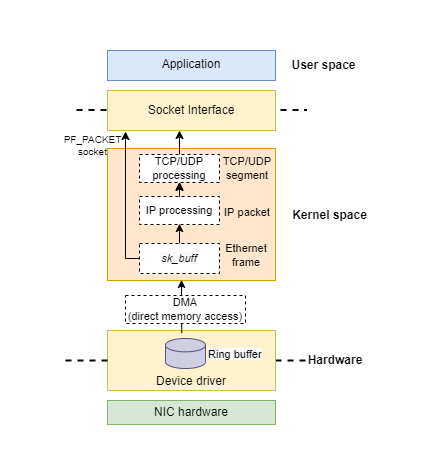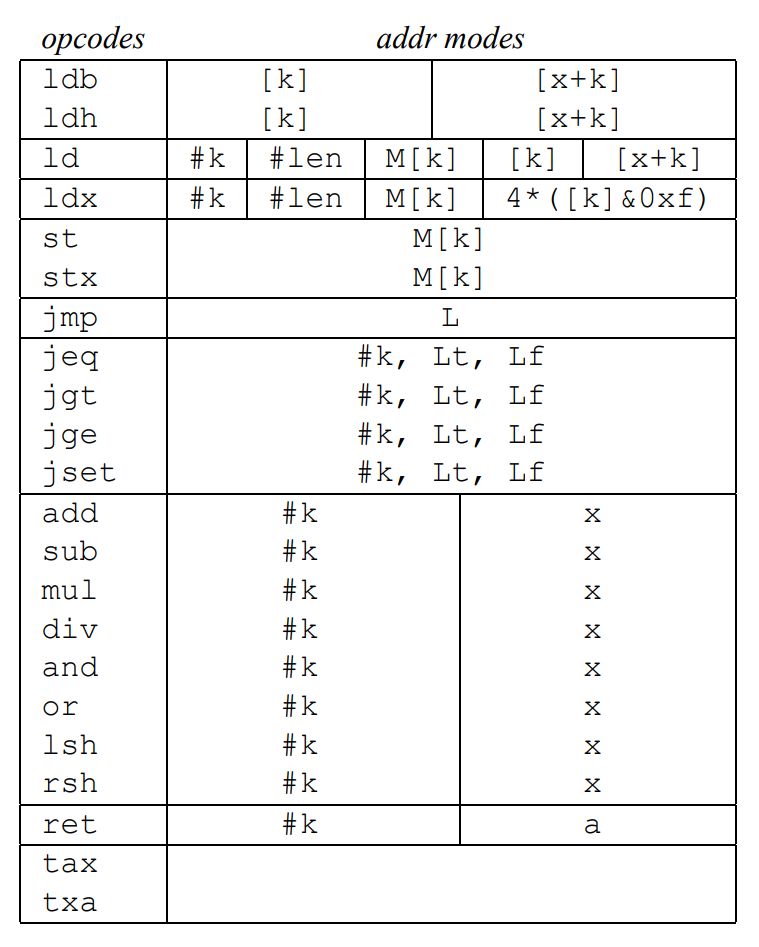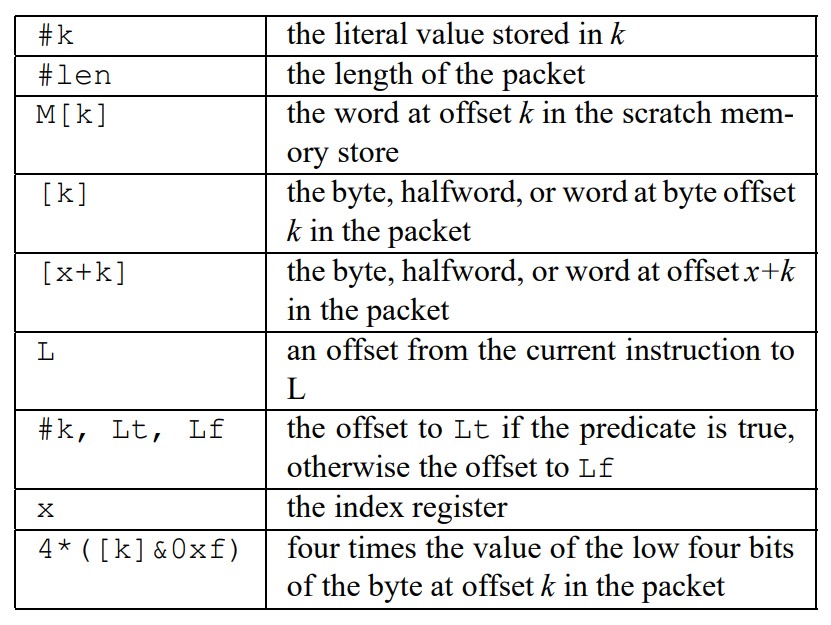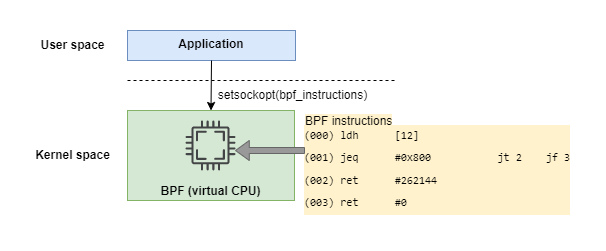Introduction
In the previous article, we examined how to develop a network sniffer with PF_SOCKET socket in Linux platform. The sniffer developed in the last article captures all the network packets. But a powerful network sniffer like tcpdump should provide the packet filtering functionality. For instance, the sniffer can only capture the TCP segment(and skip the UPD), or it can only capture the packets from a specific source IP address. In this article, let’s continue to explore how to do that.
Background of BPF
Berkeley Packet Filter(BPF) is the essential underlying technology for packet capture in Unix-like operating systems.
Search BPF as the keyword online, and the result is very confusing. It turns out that BPF keeps evolving, and there are several associated concepts such as BPF cBPF eBPF and LSF. So let us examine those concepts along the timeline:
In 1992,
BPFwas first introduced to the BSD Unix system for filtering unwanted network packets. The proposal of BPF was from researchers in Lawrence Berkeley Laboratory, who also developed thelibpcapandtcpdump.In 1997, Linux Socket Filter(LSF) was developed based on BPF and introduced in Linux kernel version 2.1.75. Note that
LSFandBPFhave some distinct differences, but in the Linux context, when we speak of BPF or LSF, we mean the same packet filtering mechanism in the Linux kernel. We’ll examine the detailed theory and design of BPF in the following sections.Originally, BPF was designed as a network packet filter. But in 2013, BPF was widely extended, and it can be used for non-networking purposes such as performance analysis and troubleshooting. Nowadays, the extended BPF is called
eBPF, and the original and obsolete version is renamed to classic BPF (cBPF). Note that what we examine in this article is cBPF, and eBPF is not inside the scope of this article.eBPFis the hottest technology in today’s software world, and I’ll talk about it in the future.
Where to place BPF
The first question to answer is where should we place the filter. The last article examines the path of a received packet as follows:

The best solution to this question is to put the filter as early as possible in the path. Since copying a large amount of data from kernel space to the user space produces a huge overhead, which can influence the system performance a lot. So BPF is a kernel feature. The filter should be triggered immediately when a packet is received at the network interface.As the original BPF paper said To minimize memory traffic, the major bottleneck in most modern system, the packet should be filtered ‘in place’ (e.g., where the network interface DMA engine put it) rather than copied to some other kernel buffer before filtering.
Let’s verify this behavior by examining the kernel source code as follows (Note the kernel code shown in this article is based on version 2.6, which contains the cBPF implementation.):
1 | /* source code file of net/packet/af_packet.c */ |
packet_create function handles the socket creation when the application calls the socket system call. In lines 11 and 14, it attaches the hook function to the socket. The hook function executes when the packet is received.
The following code block shows the hook function packet_rcv:
1 | /* hook function packet_rcv is triggered, when the packet is received */ |
packet_rcv function calls run_filter, which is just the BPF logic part(Currently, you can regard it as a black box. In the next section, we’ll examine the details). Based on the return value of run_filter the packet can be filtered out or put into the queue.
So far, you can understand BPF(or the packet filtering) is working inside kernel space. But the packet sniffer is a user-space application. The next question is how to link the filtering rules in user space to the filtering handler in kernel space.
To answer this question, we have to understand BPF itself. It’s right time to understand this great piece of work.
BPF machine
As I mentioned above, BPF was introduced in this original paper written by researchers from Berkeley. I strongly recommend you read this great paper based on my own experience. In the beginning, I felt crazy to read it, so I read other related documents and tried to understand BPF. But most documents only cover one portion of the entire system, so it is difficult to piece all the information together. Finally, I read the original paper and connected all parts together. As the saying goes, sometimes taking time is actually a shortcut.
Virtual CPU
A packet filter is simply a boolean-valued function on a packet. If the value of the function is true the kernel copies the packet for the application; if it is false the packet is ignored.
In order to be as flexible as possible and not to limit the application to a set of predefined conditions, the BPF is actually implemented as a register-based virtual machine (for the difference between stack-based and register-based virtual machine, you can refer to this article) running a user-defined program.
You can regard the BPF as a virtual CPU. And it consists of an accumulator, an index register(x), a scratch memory store, and an implicit program counter. If you’re not familiar with these concepts, I add some simple illustrations as follows:
- An
accumulatoris a type of register included in a CPU. It acts as a temporary storage location holding an intermediate value in mathematical and logical calculations. For example, in the operation of “1+2+3”, the accumulator would hold the value 1, then the value 3, then the value 6. The benefit of an accumulator is that it does not need to be explicitly referenced. - An
index registerin a computer’s CPU is a processor register or assigned memory location used for modifying operand addresses during the run of a program. - A
program counteris a CPU register in the computer processor which has the address of the next instruction to be executed from memory.
In the BPF machine, the accumulator is used for arithmetic operations, while the index register provides offsets into the packet or the scratch memory areas.
Instructions set and addressing mode
Same as the physical CPU, the BPF provides a small set of arithmetic, logical and jump instructions as follows, these instructions run on the BPF virtual machine(or CPU):

The first column opcodes lists the BPF instructions written in an assembly language style. For example, ld, ldh and ldb means to copy the indicated value into the accumulator. ldx means to copy the indicated value into the index register. jeq means jump to the target instruction if the accumulator equals the indicated value. ret means return the indicated value. You can check the functionality of the instructions set in detail in the paper.
This kind of assembly-like style is more readable to humans. But when we develop an application (like the sniffer written in this article), we use binary code directly as the BPF instruction. This kind of binary format is called BPF Bytecode. I’ll examine the way to convert this assembly language to bytecode later.
The second column addr modes lists the addressing modes allowed for each instruction. The semantics of the addressing modes are listed in the following table:

For instance, [k] means the data at byte offset k in the packet. #k means the literal value stored in k. You can read the paper in detail to check the meaning of other address modes.
Example BPF program
Now let’s try to understand the following small BPF program based on the knowledge above:
1 | (000) ldh [12] |
The BPF program consists of an array of BPF instructions. For example, the above BPF program contains four instructions.
The first instruction ldh loads a half-word(16-bit) value into the accumulator from offset 12 in the Ethernet packet. According to the Ethernet frame format shown below, the value is just the Ethernet type field. The Ethernet type is used to indicate which protocol is encapsulated in the frame’s payload (for example, 0x0806 for ARP, 0x0800 for IPv4, and 0x86DD for IPv6).

The second instruction jeq compares the accumulator (currently stores Ethernet type field) to 0x800(stands for IPv4). If the comparison fails, zero is returned, and the packet is rejected. If it is successful, a non-zero value is returned, and the packet is accepted. So the small BPF program filters and accepts all IP packets. You can find other BPF programs in the original paper. Go to read it, and you can feel the flexibility of BPF as well as the beauty of the design.
Kernel implementation of BPF
Next, let’s examine how kernel implements BPF. As mentioned above, the hook function packet_rcv calls run_filter to handle the filtering logic. run_filter is defined as follows:
1 | /* Copied from net/packet/af_packet.c */ |
You can find that the real filtering logic is inside sk_run_filter:
1 | unsigned int sk_run_filter(struct sk_buff *skb, struct sock_filter *filter, int flen) |
Same as we mentioned, sk_run_filter is simply a boolean-valued function on a packet. It maintains the accumulator, the index register, etc. as local variables. And process the array of BPF filter instructions in a for loop. Each instruction will update the value of local variables. In this way, it simulates a virtual CPU. Interesting, right?
BPF JIT
Since each network packet must go through the filtering function, it becomes the performance bottleneck of the entire system.
A just-in-time (JIT) compiler was introduced into the kernel in 2011 to speed up BPF bytecode execution.
- What is a
JITcompiler? AJITcompiler runs after the program has started and compiles the code(usually bytecode or some type of VM instructions) on the fly(or just in time) into a form that’s usually faster, typically the host CPU’s native instruction set. This is in contrast to atraditional compilerthat compiles all the code to machine language before the program is first run.
In the BPF case, the JIT compiler translates BPF bytecode into a host system’s assembly code directly, which can optimize the performance a lot. I’ll not show details about JIT in this article. You can refer to the kernel code.
Set BPF in sniffer
Next, let’s add BPF into our packet sniffer. As we mentioned above in the application level, the BPF instructions should use bytecode format with the following data structure:
1 | struct sock_filter { /* Filter block */ |
How can we convert the BPF assembly language into bytecode? There are two solutions. First, there is a small helper tool called bpf_asm(which is provided along with the Linux kernel), and you can regard it as the BPF assembly language interpreter. But it is not recommended to application developers.
Second, we can use tcpdump, which provides the converting functionality. You can find the following information from the tcpdump man page:
-d: Dump the compiled packet-matching code in a human-readable form to standard output and stop.
-dd: Dump packet-matching code as a C program fragment.
-ddd: Dump packet-matching code as decimal numbers (preceded with a count).
tcpdump ip means we want to capture all the IP packets. With options -d, -dd and -ddd, the output goes as follows:
1 | baoqger@ubuntu:~$ sudo tcpdump -d ip |
Option -d prints the BPF instructions in assembly language (same as the example BPF program shown above). Options -dd prints the bytecode as a C program fragment. So tcpdump is the most convenient tool when you want to get the BPF bytecode.
The BPF filter bytecode (wrapped in the structure sock_fprog) can be passed to the kernel through setsockopt system call as follows:
1 | // attach the filter to the socket |
setsockopt system call triggers two kernel functions: sock_setsockopt and sk_attach_filter (I’ll not show the details for these two functions), which binds the filters to the socket. And in run_filter kernel function (mentioned above), it can get the filters from the socket and execute the filters on the packet.
So far, every piece is connected. The puzzle of BPF is solved. The BPF machine allows the user-space applications to inject customized BPF programs straight into a kernel. Once loaded and verified, BPF programs execute in kernel context. These BPF programs operate inside kernel memory space with access to all the internal kernel states available to it. For example, the cBPF machine which uses the network packet data. But this power can be extended as eBPF, which can be used in many other varied applications. As someone said In some way, eBPF does to the kernel what Javascript does to the websites: it allows all sorts of new application to be created. In the future, I plan to examine eBPF in depth.

Process the packet
We examined the BPF filtering theory on the kernel level a lot in the above section. But for our tiny sniffer, the last step we need to do is process the network packet.
First, the
recvfromsystem call reads the packet from the socket. And we put the system call in awhileloop to keep reading the incoming packets.Then, we print the source and destination
MACaddress in the packet(the packet we got is a raw Ethernet frame in Layer 2, right?). And if what this Ethernet frame contains is anIP4packet, then we print out the source and destinationIPaddress. To understand more about it, you can study the header format of various network protocols. I will not cover in details here.
1 | while(1) { |
You can find the complete source code of the sniffer in this Github repo.
Summary
In this article, we examine how to add filters to our sniffer. First, we analyze why the filter should be running inside kernel space instead of the application space. Then, this article examines the BPF machine design and implementation in detail based on the paper. We reviewed the kernel source code to understand how to implement the BPF virtual machine. As I mentioned above, the original BPF(cBPF) was extended to eBPF now. But the understanding of the BPF virtual machine is very helpful to eBPF as well.